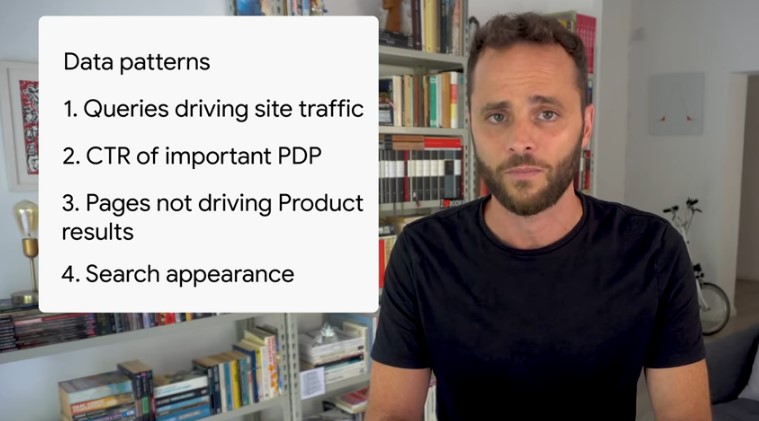SEO for e-Commerce, how to use the Search Console for business
After the developers, it is now up to those who manage e-Commerce: the lessons of Daniel Waisberg to the use of the Google Search Console, now much more than a simple suite of tools for webmasters, deepen this week the delicate world of online commerce, providing the usual support in terms of guidance, best practices and suggestions to make the most out of tools and evolve your business.
Basic questions for e-Commerce on Google
The video opens with the list of the three priority questions that should be asked by anyone who is responsible for an e-commerce site:
- Have basic SEO optimizations been implemented?
- Can Google find and show the site among search results?
- How are site content doing in terms of performance on Google?
From here begins the first part of the new episode of Google Search Console Training (from home), in which the company’s Search Advocate offers some useful food for thoughts to all those who work in the field of digital commerce and want to have good performance on the search engine.
In summary, we need to make sure we respect the basics of SEO for product pages, and then eventually consider uploading the inventory feed into Google Merchant Center, implement the structured data of the product to access Google’s multimedia results, and finally use the Search Console to monitor problems with structured data and analyze the performance of the site with such rich results.
Key optimizations for e-Commerce
According to Waisber, the first step to helping people find and browse an e-commerce site is “clearly publish all the products for sale” either in store or online or in both places, because this “will help Google to index information and show it to users looking for products to buy”.
In general, “this means creating pages on the site that explain the product to sell”, or the classic PDP – Product Detail Pages or product pages – that can be improved respecting some best practices.
Suggestions to write good product pages
First, you need to add images that allow you to clearly view the product, with faded or transparent backgrounds and with shots from different angles: this “helps visitors to the site to decide what to buy”, but at the same time can “attract users who use Google Image Search to find products”.
Equally important is to add “a detailed description of the products and highlight all the features and specifications”, because it allows users to find such products “looking for details, both in internal search and on Google”.
It is also advisable to include information on the conditions of purchase – such as, availability, price, shipping policy and any taxes – to allow customers to know the payment systems accepted and the expected times for delivery.
As we know, then, adding customer ratings and reviews can help buyers in finding the products and in the decision-making process of purchase.
Do not forget about structured data
In the work on the product pages, then, Waisberg recommends using specific structured data, which will allow Google to provide advanced search features and visual results for the site. If implemented correctly, in fact, the markup allows users to see the price, availability and rating of user reviews directly in Google search results.
Taking advantage of Google Merchant Center and Google Analytics
Moreover, the Googler reminds us, it is also possible to upload the complete inventory of products on Google Merchant Center, both for products sold online and offline: this approach has some advantages, he said, because it helps to “to update data such as prices and stock levels faster, to provide richer data, such as local information on the availability of goods, and to have more control over data, sending them personally to Google in case of changes without waiting for Google to crawl the site”.
It is also good to know that if we implemented structured data and uploaded a feed to the Merchant Center, “Google generally prioritizes feed data“.
While not really related to Search, then, you should “consider setting up Google Analytics to track e-commerce and better understand the behavior of users”, for example to analyze the “average value of orders on the site, the conversion rate of e-commerce, time for purchase and other interesting information”.
The use of Search Console for e-Commerce
After these quick (and rather essential) tips, Waisberg goes to the central topic of his Youtube series, describing how to use the tools and reports of the Search Console to monitor and improve the performance of the site and-Commerce, starting of course from the process of verification of ownership in GSC to have access to the platform.
Optimizing the presence in Search of product pages
According to the Google Search Advocate, the first aspect to pay attention to is to optimize the rich results generated by the page, making sure that structured data regularly work with the multimedia results status report to analyze the presence of any errors, warnings, and invalid entries in the markup used, such as for Products.
Errors disqualify structured data: they cannot be used to provide rich results, but the page can still be shown among search results as a simple blue link. For example, if a markup lacks the Price, Currency or valuation value fields, this generates an error in the Search Console and in SERP the page will not get multimedia results.
The alerts indicate that the page can provide a somewhat reduced experience for users, while still activating rich results in the Search. Examples of issues that generate alerts may be a lack of description, review, URL or brand.
In addition to the GSC interface, you can also use the multimedia results test to verify the validity of structured data on a given page of the site. This tool can control the syntax of structured data and, in some cases, provide an example of how the result might appear in Google Search.
Analyzing the site’s performance
After setting the pages and verifying that they are indexed, the next step is to monitor their performance: Waisberg suggests to use the Performance Report, offering some specific tips for e-commerce and, in particular, four ideas to start with for the analysis of data patterns.
- Checking on the queries bringing the most traffic to the site.
Are people looking for the name of the business, specific products or the generic type of product offered by the site? Having this information allows you to improve content in certain areas of the site and optimize the performance in the Search for the queries we want to focus on.
- Checking the CTR of the most important product pages.
It is important to keep an eye on the Click-Through Rate for the main product pages: if it is low, it means that users are not clicking on our search results, and so it may be the case to write descriptions or better titles, or add structured data.
- Checking the pages that do not give product results.
If a specific group of pages does not generate product results, this may be an opportunity to improve the implementation of structured data. For example, Waisberg says, “you may find that some products are not producing multimedia results, which may depend on a specific template that lacks structured data”.
- Checking the display in Search.
Lastly, it is always useful to check the search appareance so to understand at a glance the volume of traffic coming to the website through multimedial product results.




